The Babanango Game Reserve
Posted: Thu Jun 15, 2023 12:47 pm
Arrival of two strapping lions to Babanango spearheads pride rejuvenation in KZN
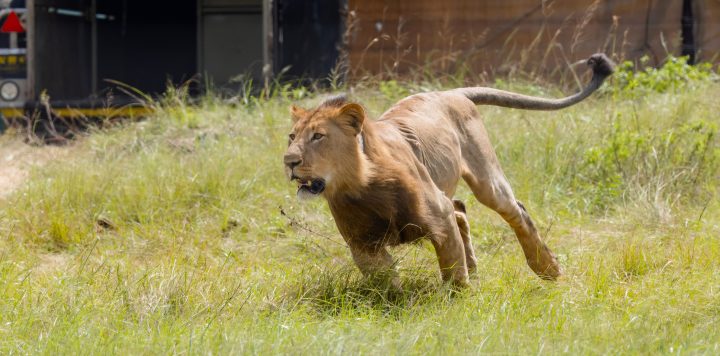
Tail outstretched and muscles rippling, a lion bursts from its capture trailer into its new home. (Photo: Dr Andrew Baxter)
By Tony Carnie | 11 Jun 2023
Wildlife managers at the newly established Babanango Game Reserve have welcomed the arrival of the two lions, the first to be seen in this part of the White Umfolozi River valley for roughly 150 years. And very soon, four female companions are set to join them.
___________________________________________________________________________________________________________________________
The appearance of two strapping lions in a remote valley in KwaZulu-Natal may not seem like much to shout about.
Until you consider several other factors, including the dramatic decline of one of Africa’s most powerful wildlife symbols over the last 60 years.
Once spread across most of the continent, the big cats have been crowded out from most of their former living spaces by relentless human development. Now the total global population of wild lions hovers at around 25 000, one step away from being reclassified as endangered.
That’s one reason why wildlife managers at the newly established Babanango Game Reserve have welcomed the arrival of the two lions, the first to be seen in this part of the White Mfolozi River valley for roughly 150 years. And very soon, four female companions are set to join them.
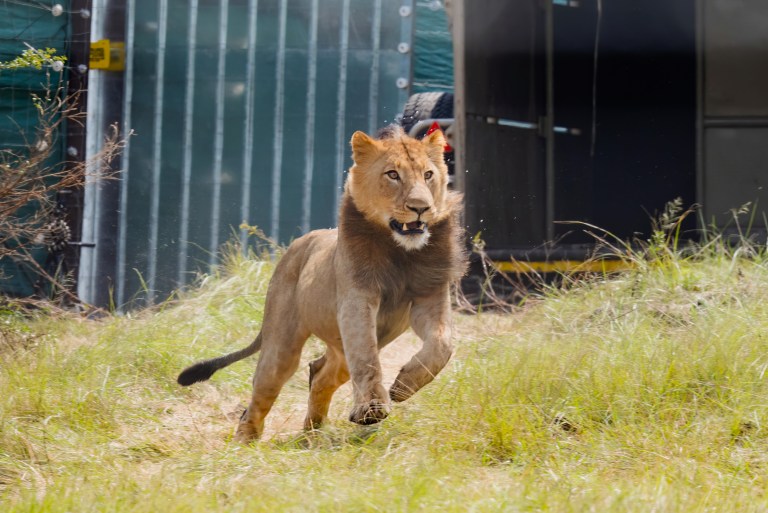
The second lion enters Babanango Game Reserve (Photo: Dr Andrew Baxter)
Another remarkable aspect of the story is that most of this 20,000ha reserve is owned by three neighbouring communities. After winning ancestral land claims they chose to consolidate a large portion into a new reserve.
https://youtu.be/-QSIr3x_c_w
Chris Galliers, from the Conservation Outcomes group, recalls that the major landowner (the Emcakwini Community Trust) put forward its ambition for eco-tourism nearly a decade ago. But, for various reasons, it was not until 2018 that work got underway to fence off the reserve and to build new tourist lodges and other visitor infrastructure.
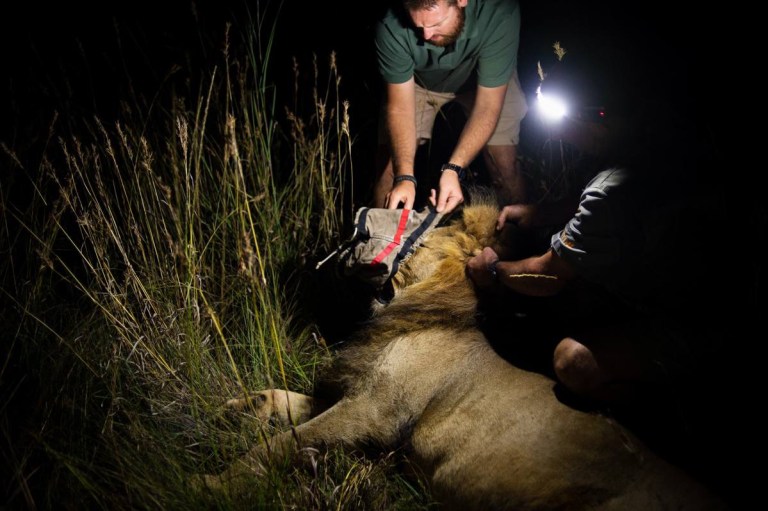
Both lions were captured at night in Nambiti Private Game Reserve before being moved to Babanango. (Photo: Casey Pratt Photography)
Conservation Outcomes is a non-profit organisation that supports biodiversity conservation projects outside the traditional state-protected areas system.
Over the last five years, Galliers says there has also been a major translocation initiative to bring more than 2,500 large mammals back into the area, including rare antelope like oribi and klipspringer.
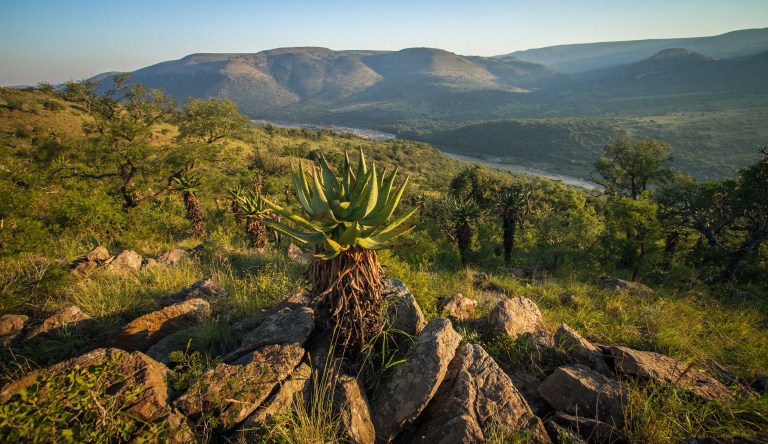
Jointly owned by three neighbouring communities, the Babanango Game Reserve features spectacular bushveld scenery. (Photo: Chris Galliers)
Three communities (Emcakwini, KwaNgono and IsiBongweni) hope to benefit from income generated through land leases, conservation levies, and other eco-tourism revenue streams.
“Introducing lions as one of the final species in the rewilding process is no small feat. Many important requirements, from food sources to infrastructure, need to be in place before any lion is released. So, to hear the sound of a lion’s roar reverberating through the valleys of Babanango, in the heart of Zululand, will be the sound of another conservation success in this incredible project,” says Galliers.
That moment arrived late last month when two males from the Nambiti Private Game Reserve near Ladysmith were translocated to Babanango.
Both animals have tracking collars to monitor their movements daily within the electrified boundary fences.
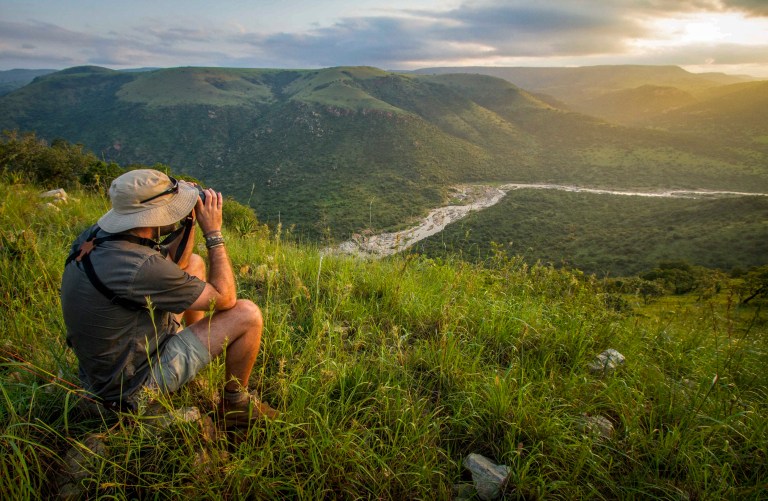
A 21 km long section of the White Mfolozi River cuts through the northern section of the reserve. (Photo: Chris Galliers)
Reserve manager Musa Mbatha notes that the return of the lions also has symbolic dimensions as Babanango lies in the heart of Zululand, close to where seven Zulu kings are buried in the “Valley of the Kings”.
From an ecological perspective, lions also play a crucial role in controlling the number of grazing species such as eland, zebra, wildebeest and buffalo. Their presence will also benefit other scavenging species, such as vultures and brown hyenas, by providing access to more food.
Elephants (the final element of the Big Five tourism magnet) are due to arrive at Babanango within months. DM.

Tail outstretched and muscles rippling, a lion bursts from its capture trailer into its new home. (Photo: Dr Andrew Baxter)
By Tony Carnie | 11 Jun 2023
Wildlife managers at the newly established Babanango Game Reserve have welcomed the arrival of the two lions, the first to be seen in this part of the White Umfolozi River valley for roughly 150 years. And very soon, four female companions are set to join them.
___________________________________________________________________________________________________________________________
The appearance of two strapping lions in a remote valley in KwaZulu-Natal may not seem like much to shout about.
Until you consider several other factors, including the dramatic decline of one of Africa’s most powerful wildlife symbols over the last 60 years.
Once spread across most of the continent, the big cats have been crowded out from most of their former living spaces by relentless human development. Now the total global population of wild lions hovers at around 25 000, one step away from being reclassified as endangered.
That’s one reason why wildlife managers at the newly established Babanango Game Reserve have welcomed the arrival of the two lions, the first to be seen in this part of the White Mfolozi River valley for roughly 150 years. And very soon, four female companions are set to join them.

The second lion enters Babanango Game Reserve (Photo: Dr Andrew Baxter)
Another remarkable aspect of the story is that most of this 20,000ha reserve is owned by three neighbouring communities. After winning ancestral land claims they chose to consolidate a large portion into a new reserve.
https://youtu.be/-QSIr3x_c_w
Chris Galliers, from the Conservation Outcomes group, recalls that the major landowner (the Emcakwini Community Trust) put forward its ambition for eco-tourism nearly a decade ago. But, for various reasons, it was not until 2018 that work got underway to fence off the reserve and to build new tourist lodges and other visitor infrastructure.

Both lions were captured at night in Nambiti Private Game Reserve before being moved to Babanango. (Photo: Casey Pratt Photography)
Conservation Outcomes is a non-profit organisation that supports biodiversity conservation projects outside the traditional state-protected areas system.
Over the last five years, Galliers says there has also been a major translocation initiative to bring more than 2,500 large mammals back into the area, including rare antelope like oribi and klipspringer.

Jointly owned by three neighbouring communities, the Babanango Game Reserve features spectacular bushveld scenery. (Photo: Chris Galliers)
Three communities (Emcakwini, KwaNgono and IsiBongweni) hope to benefit from income generated through land leases, conservation levies, and other eco-tourism revenue streams.
“Introducing lions as one of the final species in the rewilding process is no small feat. Many important requirements, from food sources to infrastructure, need to be in place before any lion is released. So, to hear the sound of a lion’s roar reverberating through the valleys of Babanango, in the heart of Zululand, will be the sound of another conservation success in this incredible project,” says Galliers.
That moment arrived late last month when two males from the Nambiti Private Game Reserve near Ladysmith were translocated to Babanango.
Both animals have tracking collars to monitor their movements daily within the electrified boundary fences.

A 21 km long section of the White Mfolozi River cuts through the northern section of the reserve. (Photo: Chris Galliers)
Reserve manager Musa Mbatha notes that the return of the lions also has symbolic dimensions as Babanango lies in the heart of Zululand, close to where seven Zulu kings are buried in the “Valley of the Kings”.
From an ecological perspective, lions also play a crucial role in controlling the number of grazing species such as eland, zebra, wildebeest and buffalo. Their presence will also benefit other scavenging species, such as vultures and brown hyenas, by providing access to more food.
Elephants (the final element of the Big Five tourism magnet) are due to arrive at Babanango within months. DM.












